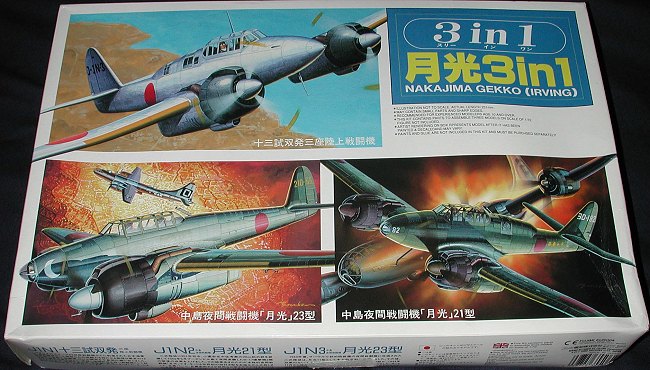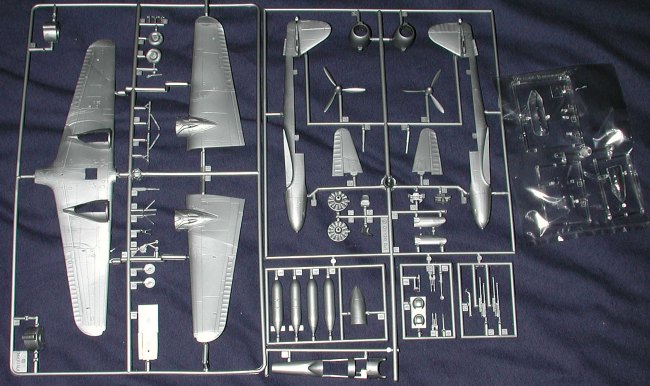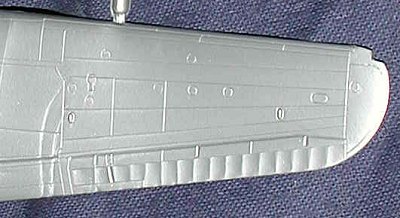
|
KIT: |
Fujimi 1/72 J1N1 Irving Set |
|
KIT # |
5410 |
|
PRICE: |
¥5800 (about $US 60-65.00) |
|
DECALS: |
See Review |
|
REVIEW & |
|
|
NOTES: |
Set includes three different versions. |

|
HISTORY |
The J1N Gekko (Moonlight) was an outstanding Japanese night fighter, although originally developed as a reconnaissance aircraft (Allied code name 'Irving'). This role change was similar to those made to the highly successful Ki-46 Dinah and C6N Myrt. A naval aircraft, the 'Irving' reflected a requirement derived during operations in China in the late 1930s. It entered service in late 1942 and was initially identified by the Allies as a twin-engine fighter aircraft (hence the male code name). It was soon adopted in the field for night-intercept missions with the specialized J1N1-S being fitted with air-intercept radar. By the end of the war 'Irvings' were being employed on kamikaze missions.
It is interesting to note that 'Irvings' were especially successful in their initial night fighting deployment to Rabaul in the northern Solomons. For many months, US aircraft on reconnaissance missions and night bombing raids would disappear and not return. No explanation was found for these losses so it was assumed that they fell afoul to anti-aircraft fire or the weather (which was always a problem in this area of operations). It wasn't until many months after these losses started increasing that a 380 BG night raid on Rabaul (which consisted of three planes), had a survivor who reported the loss of the other two planes and the heavy damage of their own to night fighters. It was then that the Gekko was discovered to be operating in that area.
First flown in May 1941, the 'Irving' probably underwent more modifications while in service than any other Japanese aircraft. Production of Nakajima-designed aircraft totaled 479, with production ending in Dec. 1944.
The 'Irving' was a low-wing, twin-engine aircraft with a long glazed cockpit housing the three-man crew. In night-fighter adaptations the crew was two. The J1N1 recce aircraft had a top speed of 329 mph and was credited with a max range of 1,675 miles. Standard armament in the recce role was one 13 mm machine gun fired from the rear of the cockpit, with some models instead having a 20 mm cannon in a dorsal turret. Those build as night fighters had a four fuselage mounted 20 mm cannon, two firing upward and two down, or two upward-firing guns and one forward-firing 20 mm gun.
|
THE KIT |

With all the hoopla currently being bandied about regarding the latest Tamiya 1/48 kit, it might not be a bad idea to look at some of the same aircraft type available in the smaller scale of 1/72. Fujimi kits have had a rather checkered career. They tend to be either superb or not the greatest. Not to say that they are unbuildable; that is not the case at all. It is just that some of them are easier to build than others. One thing that is consistent in Fujimi's WWII Japanese kits is the paucity of internal detail. This continues with these releases. There is no wheel well detail and other than basic interior bits with decals for instrument panels, no detail is to be found there as well.
 The exterior parts are the expected
engraved panel lines. Engines are front cylinder halves, which is fine for this
type since the engines are close cowled and little can be seen. The upper
fuselage is a separate part to take into account the many different variants
that are done. Each of the kits has just drop tanks as an option. One thing that
is provided are small sections of tubing that you can use to replace the kit gun
barrels.
The exterior parts are the expected
engraved panel lines. Engines are front cylinder halves, which is fine for this
type since the engines are close cowled and little can be seen. The upper
fuselage is a separate part to take into account the many different variants
that are done. Each of the kits has just drop tanks as an option. One thing that
is provided are small sections of tubing that you can use to replace the kit gun
barrels.
The three versions provided in this set are a J1N1 prototype, a Model 21 and Model 23. The prototype kit (shown) is molded in silver plastic. This is undoubtedly because the plane itself is in overall metal finish. Only one set of decals is provided for this particular kit.
The other two are molded in dark green plastic. The Model 21 is a night fighter version of the recon aircraft. These were all painted in overall dark green (and I used to think they were black) with black engine cowlings. Six different tail markings are offered for this variant, two of them with kill markings displayed on the aft fuselage. The other is the Model 23. This version has a cut down rear fuselage and a dedicated night fighter. It is painted just like the the Model 21 in overall dark green. Five different tail markings are provided on the decal sheet.
The decals are typical of Japanese kits in that they are well printed, a bit thick and probably a bit transparent as well; at least the whites and yellows. Instructions are more than adequate to help you build the kit. Colors callouts are provided as needed and referenced to Gunze paints with FS 595 numbers given where appropriate.
Overall the kit appear to be rather easy to build as there are not a great number of parts. I have never seen one built and that isn't really that surprising. MRC is/was the importer and had raised the price of Fujimi kits so high that I'm surprised that any were sold. Just one of these J1N kits was selling for over $35, an outrageous price to ask for such a simple kit!
Review kit courtesy of me and my wallet!
If you would like your product reviewed fairly and quickly by a site that averages over 175,000 visitors a month, please contact me or see other details in the Note to Contributors.